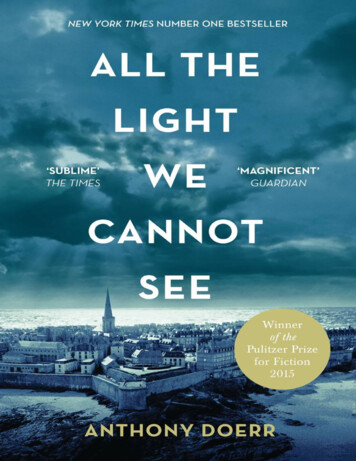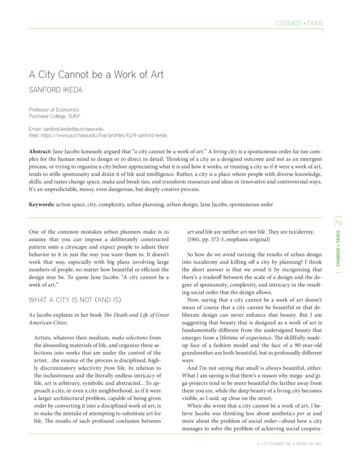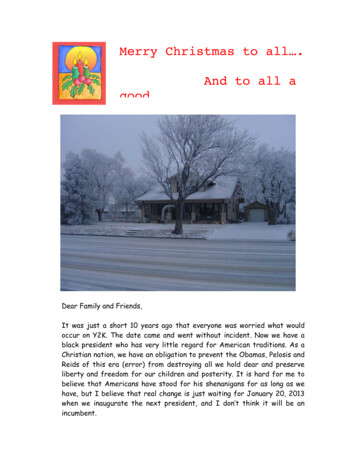
Transcription
CopyrightFourth EstateAn imprint of HarperCollinsPublishers1 London Bridge StreetLondon SE1 9GFwww.4thestate.co.ukThis eBook first published in Great Britain by Fourth Estate in 2014Copyright Anthony Doerr 2014Extract from About Grace Anthony Doerr 2005Cover design by Tal Goretsky and Lynn BuckleyCover photographs: Manuel Clauzier (San Malo); George Eastman House/Getty images (sky)The right of Anthony Doerr to be identified as the author of this work has been asserted by him inaccordance with the Copyright, Design and Patents Act 1988.A catalogue record for this book is available from the British Library.This book is a work of fiction. Any references to historical events, real people or real places areused fictitiously. Other names, characters, places and events are products of the author’s imagination,and any resemblance to actual events or places or persons, living or dead, is entirely coincidental.All rights reserved under International and Pan-American Copyright Conventions. By payment of therequired fees, you have been granted the non-exclusive, non-transferable right to access and read thetext of this e-book on-screen. No part of this text may be reproduced, transmitted, down-loaded,decompiled, reverse engineered, or stored in or introduced into any information storage and retrievalsystem, in any form or by any means, whether electronic or mechanical, now known or hereinafterinvented, without the express written permission of HarperCollins.Source ISBN: 9780008138301Ebook Edition April 2015 ISBN: 9780007548682Version: 2017-03-14
DedicationFor Wendy Weil1940–2012
EpigraphSaint-Malo, the brightest jewel of the Emerald Coast The city looked picturesque and solid from the sea but as we got nearthe landing place we realized that the houses visible above the walls were just burnt-out shells Of the 865 buildings within thewalls, only 182 remained standing and all were damaged to some degree.—Philip BeckIt would not have been possible for us to take power or to use it in the ways we have without the radio.—Joseph Goebbels
ContentsCoverTitle PageCopyrightDedicationEpigraphPart Zero: 7 August 1944LeafletsBombersThe GirlThe BoySaint-MaloNumber 4 rue VauborelCellarBombs AwayPart One: 1934Muséum National d’Histoire NaturelleZollvereinKey PoundRadioTake Us HomeSomething RisingLightOur Flag Flutters Before UsAround the World in Eighty DaysThe ProfessorSea of FlamesOpen Your EyesFadeThe Principles of MechanicsRumorsBigger Faster Brighter
Mark of the BeastGood Evening. Or Heil Hitler if You Prefer.Bye-bye, Blind GirlMaking SocksFlightHerr SiedlerExodusPart Two: 8 August 1944Saint-MaloNumber 4 rue VauborelHotel of BeesDown Six FlightsTrappedPart Three: June 1940ChâteauEntrance ExamBrittanyMadame ManecYou Have Been CalledOccuperDon’t Tell LiesEtienneJungmännerViennaThe BochesHauptmannFlying CouchThe Sum of AnglesThe ProfessorPerfumerTime of the OstrichesWeakestMandatory Surrender
MuseumThe WardrobeBlackbirdsBathWeakest (#2)The Arrest of the LocksmithPart Four: 8 August 1944The Fort of La CitéAtelier de RéparationTwo CansNumber 4 rue VauborelWhat They HaveTrip WirePart Five: January 1941January RecessHe Is Not Coming BackPrisonerPlage du MôleLapidaryEntropyThe RoundsNadel im HeuhaufenProposalYou Have Other FriendsOld Ladies’ Resistance ClubDiagnosisWeakest (#3)GrottoIntoxicatedThe Blade and the WhelkAlive Before You DieNo OutThe Disappearance of Hubert Bazin
Everything PoisonedVisitorsThe Frog sePart Six: 8 August 1944Someone in the HouseThe Death of Walter BerndSixth-floor BedroomMaking the RadioIn the AtticPart Seven: August 1942PrisonersThe WardrobeEastOne Ordinary LoafVolkheimerFallSunflowersStonesGrottoHuntingThe MessagesLoudenvielleGrayFeverThe Third StoneThe BridgeRue des Patriarches
White CityTwenty Thousand Leagues Under the SeaTelegramPart Eight: 9 August 1944Fort NationalIn the AtticThe HeadsDeliriumWaterThe BeamsThe TransmitterVoicePart Nine: May 1944Edge of the WorldNumbersMayHunting (Again)“Clair de Lune”AntennaBig ClaudeBoulangerieGrottoAgoraphobiaNothingForty MinutesThe GirlLittle HouseNumbersSea of FlamesThe Arrest of Etienne LeBlanc7 August 1944Leaflets
Part Ten: 12 August 1944EntombedFort NationalCaptain Nemo’s Last WordsVisitorFinal SentenceMusic #1Music #2Music #3OutWardrobeComradesThe Simultaneity of InstantsAre You There?Second CanBirds of AmericaCease-fireChocolateLightPart Eleven: 1945BerlinParisPart Twelve: orPaper AirplaneThe KeySea of FlamesFrederick
Part Thirteen: 2014AcknowledgmentsAbout GraceAlso by Anthony DoerrAbout the AuthorAbout the Publisher
Zero
7 August 1944
LeafletsAt dusk they pour from the sky. They blow across the ramparts, turn cartwheels over rooftops, flutterinto the ravines between houses. Entire streets swirl with them, flashing white against the cobbles.Urgent message to the inhabitants of this town, they say. Depart immediately to open country.The tide climbs. The moon hangs small and yellow and gibbous. On the rooftops of beachfronthotels to the east, and in the gardens behind them, a half-dozen American artillery units dropincendiary rounds into the mouths of mortars.
BombersThey cross the Channel at midnight. There are twelve and they are named for songs: StardustandStormy Weather and In the Mood and Pistol-Packin’ Mama. The sea glides along far below,spattered with the countless chevrons of whitecaps. Soon enough, the navigators can discern the lowmoonlit lumps of islands ranged along the horizon.France.Intercoms crackle. Deliberately, almost lazily, the bombers shed altitude. Threads of red lightascend from anti-air emplacements up and down the coast. Dark, ruined ships appear, scuttled ordestroyed, one with its bow shorn away, a second flickering as it burns. On an outermost island,panicked sheep run zigzagging between rocks.Inside each airplane, a bombardier peers through an aiming window and counts to twenty. Fourfive six seven. To the bombardiers, the walled city on its granite headland, drawing ever closer, lookslike an unholy tooth, something black and dangerous, a final abscess to be lanced away.
The GirlIn a corner of the city, inside a tall, narrow house at Number 4 rue Vauborel, on the sixth and highestfloor, a sightless sixteen-year-old named Marie-Laure LeBlanc kneels over a low table coveredentirely with a model. The model is a miniature of the city she kneels within, and contains scalereplicas of the hundreds of houses and shops and hotels within its walls. There’s the cathedral withits perforated spire, and the bulky old Château de Saint-Malo, and row after row of seaside mansionsstudded with chimneys. A slender wooden jetty arcs out from a beach called the Plage du Môle; adelicate, reticulated atrium vaults over the seafood market; minute benches, the smallest no largerthan apple seeds, dot the tiny public squares.Marie-Laure runs her fingertips along the centimeter-wide parapet crowning the ramparts, drawingan uneven star shape around the entire model. She finds the opening atop the walls where fourceremonial cannons point to sea. “Bastion de la Hollande,” she whispers, and her fingers walk downa little staircase. “Rue des Cordiers. Rue Jacques Cartier.”In a corner of the room stand two galvanized buckets filled to the rim with water. Fill them up, hergreat-uncle has taught her, whenever you can. The bathtub on the third floor too. Who knows when thewater will go out again.Her fingers travel back to the cathedral spire. South to the Gate of Dinan. All evening she has beenmarching her fingers around the model, waiting for her great-uncle Etienne, who owns this house,who went out the previous night while she slept, and who has not returned. And now it is night again,another revolution of the clock, and the whole block is quiet, and she cannot sleep.She can hear the bombers when they are three miles away. A mounting static. The hum inside aseashell.When she opens the bedroom window, the noise of the airplanes becomes louder. Otherwise, thenight is dreadfully silent: no engines, no voices, no clatter. No sirens. No footfalls on the cobbles. Noteven gulls. Just a high tide, one block away and six stories below, lapping at the base of the citywalls.And something else.Something rattling softly, very close. She eases open the left-hand shutter and runs her fingers upthe slats of the right. A sheet of paper has lodged there.She holds it to her nose. It smells of fresh ink. Gasoline, maybe. The paper is crisp; it has not beenoutside long.Marie-Laure hesitates at the window in her stocking feet, her bedroom behind her, seashellsarranged along the top of the armoire, pebbles along the baseboards. Her cane stands in the corner;her big Braille novel waits facedown on the bed. The drone of the airplanes grows.
The BoyFive streets to the north, a white-haired eighteen-year-old German private named Werner Pfennigwakes to a faint staccato hum. Little more than a purr. Flies tapping at a far-off windowpane.Where is he? The sweet, slightly chemical scent of gun oil; the raw wood of newly constructedshell crates; the mothballed odor of old bedspreads—he’s in the hotel. Of course. L’hôtel desAbeilles, the Hotel of Bees.Still night. Still early.From the direction of the sea come whistles and booms; flak is going up.An anti-air corporal hurries down the corridor, heading for the stairwell. “Get to the cellar,” hecalls over his shoulder, and Werner switches on his field light, rolls his blanket into his duffel, andstarts down the hall.Not so long ago, the Hotel of Bees was a cheerful address, with bright blue shutters on its facadeand oysters on ice in its café and Breton waiters in bow ties polishing glasses behind its bar. Itoffered twenty-one guest rooms, commanding sea views, and a lobby fireplace as big as a truck.Parisians on weekend holidays would drink aperitifs here, and before them the occasional emissaryfrom the republic—ministers and vice ministers and abbots and admirals—and in the centuries beforethem, windburned corsairs: killers, plunderers, raiders, seamen.Before that, before it was ever a hotel at all, five full centuries ago, it was the home of a wealthyprivateer who gave up raiding ships to study bees in the pastures outside Saint-Malo, scribbling innotebooks and eating honey straight from combs. The crests above the door lintels still havebumblebees carved into the oak; the ivy-covered fountain in the courtyard is shaped like a hive.Werner’s favorites are five faded frescoes on the ceilings of the grandest upper rooms, where bees asbig as children float against blue backdrops, big lazy drones and workers with diaphanous wings—where, above a hexagonal bathtub, a single nine-foot-long queen, with multiple eyes and a goldenfurred abdomen, curls across the ceiling.Over the past four weeks, the hotel has become something else: a fortress. A detachment ofAustrian anti-airmen has boarded up every window, overturned every bed. They’ve reinforced theentrance, packed the stairwells with crates of artillery shells. The hotel’s fourth floor, where gardenrooms with French balconies open directly onto the ramparts, has become home to an aging highvelocity anti-air gun called an 88 that can fire twenty-one-and-a-half-pound shells nine miles.Her Majesty, the Austrians call their cannon, and for the past week these men have tended to it theway worker bees might tend to a queen. They’ve fed her oils, repainted her barrels, lubricated herwheels; they’ve arranged sandbags at her feet like offerings.The royal acht acht, a deathly monarch meant to protect them all.Werner is in the stairwell, halfway to the ground floor, when the 88 fires twice in quick succession.It’s the first time he’s heard the gun at such close range, and it sounds as if the top half of the hotel has
torn off. He stumbles and throws his arms over his ears. The walls reverberate all the way down intothe foundation, then back up.Werner can hear the Austrians two floors up scrambling, reloading, and the receding screams ofboth shells as they hurtle above the ocean, already two or three miles away. One of the soldiers, herealizes, is singing. Or maybe it is more than one. Maybe they are all singing. Eight Luftwaffe men,none of whom will survive the hour, singing a love song to their queen.Werner chases the beam of his field light through the lobby. The big gun detonates a third time, andglass shatters somewhere close by, and torrents of soot rattle down the chimney, and the walls of thehotel toll like a struck bell. Werner worries that the sound will knock the teeth from his gums.He drags open the cellar door and pauses a moment, vision swimming. “This is it?” he asks.“They’re really coming?”But who is there to answer?
Saint-MaloUp and down the lanes, the last unevacuated townspeople wake, groan, sigh. Spinsters, prostitutes,men over sixty. Procrastinators, collaborators, disbelievers, drunks. Nuns of every order. The poor.The stubborn. The blind.Some hurry to bomb shelters. Some tell themselves it is merely a drill. Some linger to grab ablanket or a prayer book or a deck of playing cards.D-day was two months ago. Cherbourg has been liberated, Caen liberated, Rennes too. Half ofwestern France is free. In the east, the Soviets have retaken Minsk; the Polish Home Army isrevolting in Warsaw; a few newspapers have become bold enough to suggest that the tide has turned.But not here. Not this last citadel at the edge of the continent, this final German strongpoint on theBreton coast.Here, people whisper, the Germans have renovated two kilometers of subterranean corridors underthe medieval walls; they have built new defenses, new conduits, new escape routes, undergroundcomplexes of bewildering intricacy. Beneath the peninsular fort of La Cité, across the river from theold city, there are rooms of bandages, rooms of ammunition, even an underground hospital, or so it isbelieved. There is air-conditioning, a two-hundred-thousand-liter water tank, a direct line to Berlin.There are flame-throwing booby traps, a net of pillboxes with periscopic sights; they have stockpiledenough ordnance to spray shells into the sea all day, every day, for a year.Here, they whisper, are a thousand Germans ready to die. Or five thousand. Maybe more.Saint-Malo: Water surrounds the city on four sides. Its link to the rest of France is tenuous: acauseway, a bridge, a spit of sand. We are Malouins first, say the people of Saint-Malo. Bretons next.French if there’s anything left over.In stormy light, its granite glows blue. At the highest tides, the sea creeps into basements at the verycenter of town. At the lowest tides, the barnacled ribs of a thousand shipwrecks stick out above thesea.For three thousand years, this little promontory has known sieges.But never like this.A grandmother lifts a fussy toddler to her chest. A drunk, urinating in an alley outside Saint-Servan,a mile away, plucks a sheet of paper from a hedge. Urgent message to the inhabitants of this town, itsays. Depart immediately to open country.Anti-air batteries flash on the outer islands, and the big German guns inside the old city sendanother round of shells howling over the sea, and three hundred and eighty Frenchmen imprisoned onan island fortress called National, a quarter mile off the beach, huddle in a moonlit courtyard peeringup.Four years of occupation, and the roar of oncoming bombers is the roar of what? Deliverance?Extirpation?
The clack-clack of small-arms fire. The gravelly snare drums of flak. A dozen pigeons roosting onthe cathedral spire cataract down its length and wheel out over the sea.
Number 4 rue VauborelMarie-Laure LeBlanc stands alone in her bedroom smelling a leaflet she cannot read. Sirens wail.She closes the shutters and relatches the window. Every second the airplanes draw closer; everysecond is a second lost. She should be rushing downstairs. She should be making for the corner of thekitchen where a little trapdoor opens into a cellar full of dust and mouse-chewed rugs and ancienttrunks long unopened.Instead she returns to the table at the foot of the bed and kneels beside the model of the city.Again her fingers find the outer ramparts, the Bastion de la Hollande, the little staircase leadingdown. In this window, right here, in the real city, a woman beats her rugs every Sunday. From thiswindow here, a boy once yelled, Watch where you’re going, are you blind?The windowpanes rattle in their housings. The anti-air guns unleash another volley. The earthrotates just a bit farther.Beneath her fingertips, the miniature rue d’Estrées intersects the miniature rue Vauborel. Herfingers turn right; they skim doorways. One two three. Four. How many times has she done this?Number 4: the tall, derelict bird’s nest of a house owned by her great-uncle Etienne. Where she haslived for four years. Where she kneels on the sixth floor alone, as a dozen American bombers roartoward her.She presses inward on the tiny front door, and a hidden catch releases, and the little house lifts upand out of the model. In her hands, it’s about the size of one of her father’s cigarette boxes.Now the bombers are so close that the floor starts to throb under her knees. Out in the hall, thecrystal pendants of the chandelier suspended above the stairwell chime. Marie-Laure twists thechimney of the miniature house ninety degrees. Then she slides off three wooden panels that make upits roof, and turns it over.A stone drops into her palm.It’s cold. The size of a pigeon’s egg. The shape of a teardrop.Marie-Laure clutches the tiny house in one hand and the stone in the other. The room feels flimsy,tenuous. Giant fingertips seem about to punch through its walls.“Papa?” she whispers.
CellarBeneath the lobby of the Hotel of Bees, a corsair’s cellar has been hacked out of the bedrock. Behindcrates and cabinets and pegboards of tools, the walls are bare granite. Three massive hand-hewnbeams, hauled here from some ancient Breton forest and craned into place centuries ago by teams ofhorses, hold up the ceiling.A single lightbulb casts everything in a wavering shadow.Werner Pfennig sits on a folding chair in front of a workbench, checks his battery level, and puts onheadphones. The radio is a steel-cased two-way transceiver with a 1.6-meter band antenna. It enableshim to communicate with a matching transceiver upstairs, with two other anti-air batteries inside thewalls of the city, and with the underground garrison command across the river mouth.The transceiver hums as it warms. A spotter reads coordinates into the headpiece, and anartilleryman repeats them back. Werner rubs his eyes. Behind him, confiscated treasures are crammedto the ceiling: rolled tapestries, grandfather clocks, armoires, and giant landscape paintings crazedwith cracks. On a shelf opposite Werner sit eight or nine plaster heads, the purpose of which hecannot guess.The massive staff sergeant Frank Volkheimer comes down the narrow wooden stairs and ducks hishead beneath the beams. He smiles gently at Werner and sits in a tall-backed armchair upholstered ingolden silk with his rifle across his huge thighs, where it looks like little more than a baton.Werner says, “It’s starting?”Volkheimer nods. He switches off his field light and blinks his strangely delicate eyelashes in thedimness.“How long will it last?”“Not long. We’ll be safe down here.”The engineer, Bernd, comes last. He is a little man with mousy hair and misaligned pupils. Hecloses the cellar door behind him and bars it and sits halfway down the wooden staircase with adamp look on his face, fear or grit, it’s hard to say.With the door shut, the sound of the sirens softens. Above them, the ceiling bulb flickers.Water, thinks Werner. I forgot water.A second anti-air battery fires from a distant corner of the city, and then the 88 upstairs goes again,stentorian, deadly, and Werner listens to the shell scream into the sky. Cascades of dust hiss out of theceiling. Through his headphones, Werner can hear the Austrians upstairs still singing. auf d’Wulda, auf d’Wulda, da scheint d’Sunn a so gulda Volkheimer picks sleepily at a stain on his trousers. Bernd blows into his cupped hands. Thetransceiver crackles with wind speeds, air pressure, trajectories. Werner thinks of home: Frau Elenabent over his little shoes, double-knotting each lace. Stars wheeling past a dormer window. His littlesister, Jutta, with a quilt around her shoulders and a radio earpiece trailing from her left ear.
Four stories up, the Austrians clap another shell into the smoking breech of the 88 and doublecheck the traverse and clamp their ears as the gun discharges, but down here Werner hears only theradio voices of his childhood. The Goddess of History looked down to earth. Only through thehottest fires can purification be achieved. He sees a forest of dying sunflowers. He sees a flock ofblackbirds explode out of a tree.
Bombs AwaySeventeen eighteen nineteen twenty. Now the sea races beneath the aiming windows. Now rooftops.Two smaller aircraft line the corridor with smoke, and the lead bomber salvos its payload, andeleven others follow suit. The bombs fall diagonally; the bombers rise and scramble.The underside of the sky goes black with flecks. Marie-Laure’s great-uncle, locked with severalhundred others inside the gates of Fort National, a quarter mile offshore, squints up and thinks,Locusts, and an Old Testament proverb comes back to him from some cobwebbed hour of parishschool: The locusts have no king, yet all of them go out in ranks.A demonic horde. Upended sacks of beans. A hundred broken rosaries. There are a thousandmetaphors and all of them are inadequate: forty bombs per aircraft, four hundred and eightyaltogether, seventy-two thousand pounds of explosives.An avalanche descends onto the city. A hurricane. Teacups drift off shelves. Paintings slip off nails.In another quarter second, the sirens are inaudible. Everything is inaudible. The roar becomes loudenough to separate membranes in the middle ear.The anti-air guns let fly their final shells. Twelve bombers fold back unharmed into the blue night.On the sixth floor of Number 4 rue Vauborel, Marie-Laure crawls beneath her bed and clamps thestone and little model house to her chest.In the cellar beneath the Hotel of Bees, the single bulb in the ceiling winks out.
One
1934
Muséum National d’Histoire NaturelleMarie-Laure LeBlanc is a tall and freckled six-year-old in Paris with rapidly deteriorating eyesightwhen her father sends her on a children’s tour of the museum where he works. The guide is ahunchbacked old warder hardly taller than a child himself. He raps the tip of his cane against the floorfor attention, then leads his dozen charges across the gardens to the galleries.The children watch engineers use pulleys to lift a fossilized dinosaur femur. They see a stuffedgiraffe in a closet, patches of hide wearing off its back. They peer into taxidermists’ drawers full offeathers and talons and glass eyeballs; they flip through two-hundred-year-old herbarium sheetsbedecked with orchids and daisies and herbs.Eventually they climb sixteen steps into the Gallery of Mineralogy. The guide shows them agatefrom Brazil and violet amethysts and a meteorite on a pedestal that he claims is as ancient as the solarsystem itself. Then he leads them single file down two twisting staircases and along several corridorsand stops outside an iron door with a single keyhole. “End of tour,” he says.A girl says, “But what’s through there?”“Behind this door is another locked door, slightly smaller.”“And what’s behind that?”“A third locked door, smaller yet.”“What’s behind that?”“A fourth door, and a fifth, on and on until you reach a thirteenth, a little locked door no bigger thana shoe.”The children lean forward. “And then?”“Behind the thirteenth door”—the guide flourishes one of his impossibly wrinkled hands—“is theSea of Flames.”Puzzlement. Fidgeting.“Come now. You’ve never heard of the Sea of Flames?”The children shake their heads. Marie-Laure squints up at the naked bulbs strung in three-yardintervals along the ceiling; each sets a rainbow-colored halo rotating in her vision.The guide hangs his cane on his wrist and rubs his hands together. “It’s a long story. Do you want tohear a long story?”They nod.He clears his throat. “Centuries ago, in the place we now call Borneo, a prince plucked a bluestone from a dry riverbed because he thought it was pretty. But on the way back to his palace, theprince was attacked by men on horseback and stabbed in the heart.”“Stabbed in the heart?”“Is this true?”A boy says, “Hush.”
“The thieves stole his rings, his horse, everything. But because the little blue stone was clenched inhis fist, they did not discover it. And the dying prince managed to crawl home. Then he fellunconscious for ten days. On the tenth day, to the amazement of his nurses, he sat up, opened his hand,and there was the stone.“The sultan’s doctors said it was a miracle, that the prince never should have survived such aviolent wound. The nurses said the stone must have healing powers. The sultan’s jewelers saidsomething else: they said the stone was the largest raw diamond anyone had ever seen. Their mostgifted stonecutter spent eighty days faceting it, and when he was done, it was a brilliant blue, the blueof tropical seas, but it had a touch of red at its center, like flames inside a drop of water. The sultanhad the diamond fitted into a crown for the prince, and it was said that when the young prince sat onhis throne and the sun hit him just so, he became so dazzling that visitors could not distinguish hisfigure from light itself.”“Are you sure this is true?” asks a girl.“Hush,” says the boy.“The stone came to be known as the Sea of Flames. Some believed the prince was a deity, that aslong as he kept the stone, he could not be killed. But something strange began to happen: the longer theprince wore his crown, the worse his luck became. In a month, he lost a brother to drowning and asecond brother to snakebite. Within six months, his father died of disease. To make matters evenworse, the sultan’s scouts announced that a great army was gathering in the east.“The prince called together his father’s advisers. All said he should prepare for war, all but one, apriest, who said he’d had a dream. In the dream the Goddess of the Earth told him she’d made the Seaof Flames as a gift for her lover, the God of the Sea, and was sending the jewel to him through theriver. But when the river dried up, and the prince plucked it out, the goddess became enraged. Shecursed the stone and whoever kept it.”Every child leans forward, Marie-Laure along with them.“The curse was this: the keeper of the stone would live forever, but so long as he kept it,misfortunes would fall on all those he loved one after another in unending rain.”“Live forever?”“But if the keeper threw the diamond into the sea, thereby delivering it to its rightful recipient, thegoddess would lift the curse. So the prince, now sultan, thought for three days and three nights andfinally decided to keep the stone. It had saved his life; he believed it made him indestructible. He hadthe tongue cut out of the priest’s mouth.”“Ouch,” says the youngest boy.“Big mistake,” says the tallest girl.“The invaders came,” says the warder, “and destroyed the palace, and killed everyone they found,and the prince was never seen again, and for two hundred years no one heard any more about the Seaof Flames. Some said the stone was recut into many smaller stones; others said the prince still carriedthe stone, that he was in Japan or Persia, that he was a humble farmer, that he never seemed to growold.“And so the stone fell out of history. Until one day, when a French diamond trader, during a trip tothe Golconda Mines in India, was shown a massive pear-cut diamond. One hundred and thirty-threecarats. Near-perfect clarity. As big as a pigeon’s egg, he wrote, and as blue as the sea, but with aflare of red at its core. He made a casting of the stone and sent it to a gem-crazy duke in Lorraine,
warning him of the rumors of a curse. But the duke wanted the diamond very badly. So the traderbrought it to Europe, and the duke fitted it into the end of a walking stick and carried it everywhere.”“Uh-oh.”“Within a month, the duchess contracted a throat disease. Two of their favorite servants fell off theroof and broke their necks. Then the duke’s only son died in a riding accident. Though everyone saidthe duke himself had never looked better, he became afraid to go out, afraid to accept visitors.Eventually he was so convinced that his stone was the accursed Sea of Flames that he asked the kingto shut it up in his museum on the conditions that it be locked deep inside a specially built vault andthe vault not be opened for two hundred years.”“And?”“And one hundred and ninety-six years have passed.”All the children remain quiet a moment. Several do math on their fingers. Then they raise theirhands as one. “Can we see it?”“No.”“Not even open the first door?”“No.”“Have you seen it?”“I have not.”“So how do you know it’s really there?”“You have to believe the story.”“How much is it worth, Monsieur? Could it buy the Eiffel Tower?”“A diamond that large and rare could in all likelihood buy five Eiffel Towers.”Gasps.“Are all those doors to keep thieves from getting in?”“Maybe,” the guide says, and winks, “they’re there to keep the curse from getting out.”The children fall quiet. Two or three take a step back.Marie-Laure takes off her eyeglasses, and the world goes shapeless. “Why not,” she asks, “justtake the diamond and throw it into the sea?”The warder looks at her. The other children look at her. “When is the last time,” one of the olderboys says, “you saw someone throw five Eiffel Towers into the sea?”There is laughter. Marie-La
Mar 14, 2017 · the landing place we realized that the houses visible above the walls were just burnt-out shells Of the 865 buildings within the walls, only 182 remained standing and all were damaged to some degree. —Philip Beck It would not have been possible for us to take power or to use it in the ways we have without the radio. —Joseph GoebbelsFile Size: 1MB











